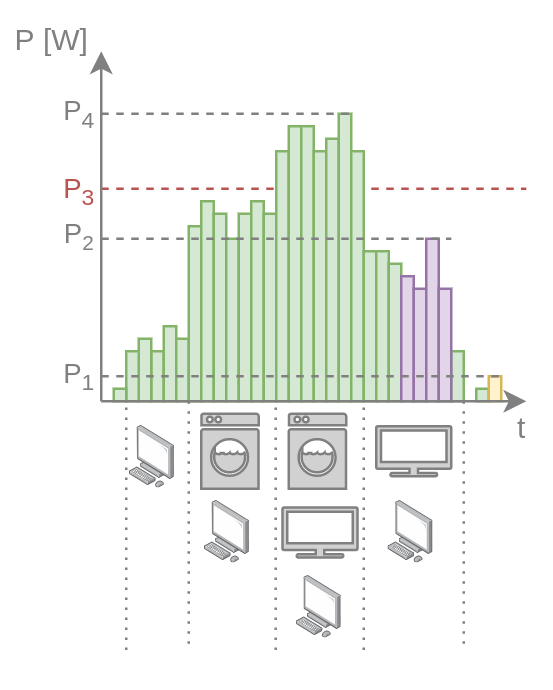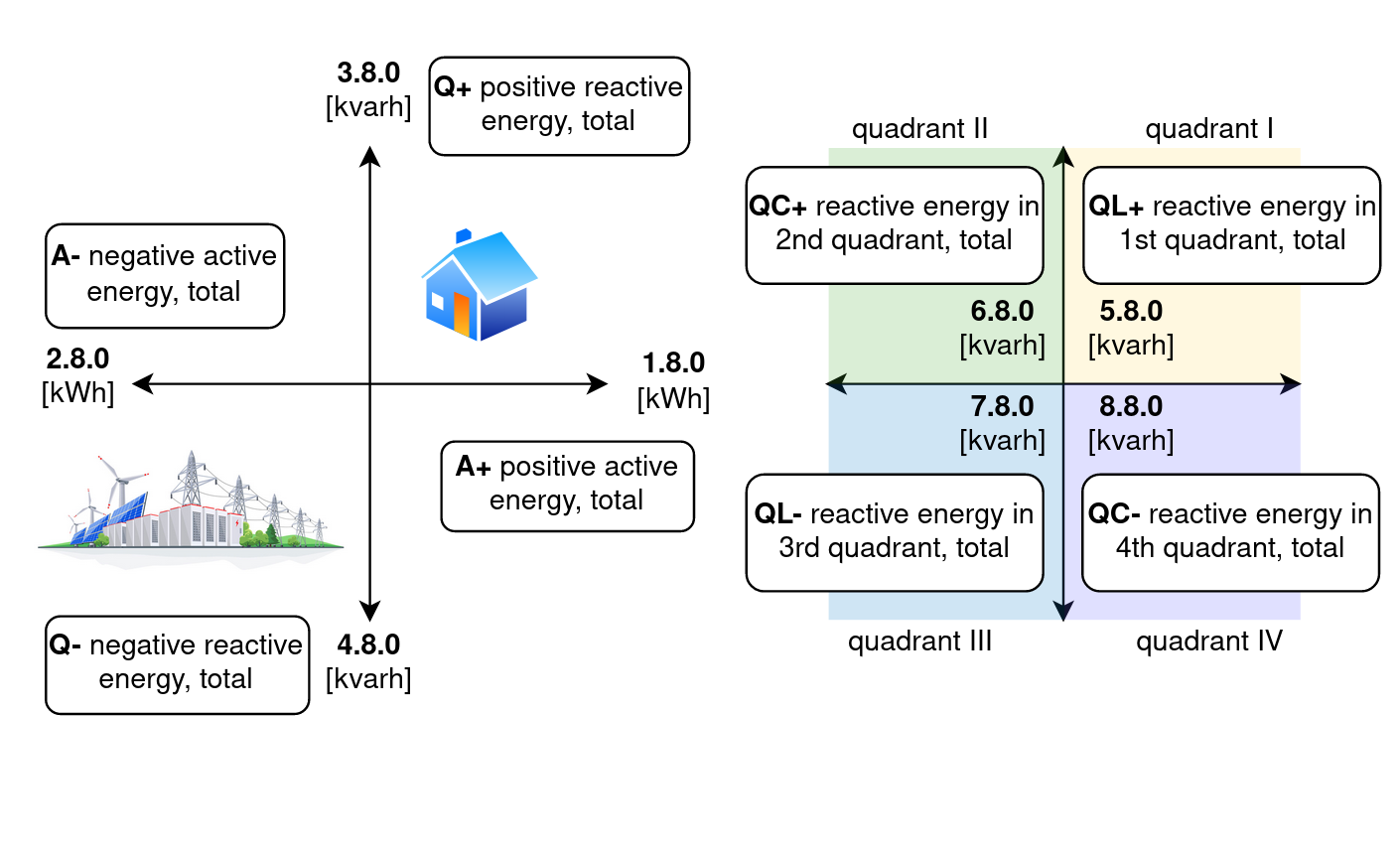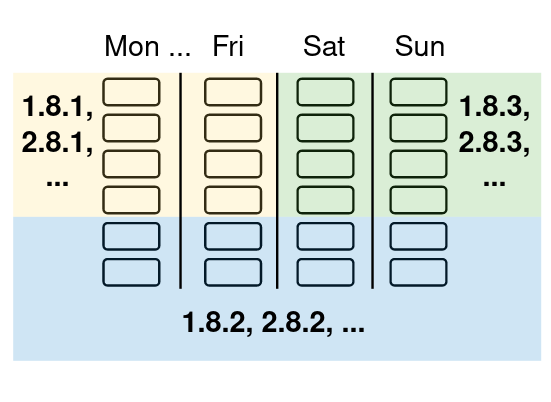Physics¶
To better understand the topic of reading electrical data, let's introduce a few concepts. These will be for electricity, but the same applies to electricity.
The following descriptions are simplified and do not strictly follow the technical definitions.
Definitions¶
Circuit¶
Combination of an energy source (e.g. battery, power supply) connected by wire (e.g. with a copper or aluminum cable) with elements that process it (e.g. light bulb, loudspeaker, processor).
Energy source¶
Element of circuit which provides the voltage or current - constant (DC) or alternate (AC). For example, power supply.
Phase¶
Generic term for energy source in an electrical network or the waveform signal of such source. In 3-phase network, we have thee phases (sources) which have the voltages of phases (signals) shifted 120° from each other.
What does it mean? You can imagine three partially independent energy sources which allow to connect a greater number of electrical devices to the network compared to the capabilities of a similarly formed single-phase network.
Load¶
The set of elements which processing the energy, connected to the energy source.
Zespół elementów przetwarzających energię, podłączony do źródła energii.
Counter¶
Measurement system of single physical quantity in the meter. For example, 1.8.0 means the sum of positive active energy. Usually, a value of counter is non-negative.
One-phase meter¶
Energy meter which performs measurements on a single phase using counters.
Three-phase meter¶
Energy meter which performs measurements on three phase using counters.
Power¶
(P1) Instantaneous power [W] is the power consumed by the load (energy receivers) at a moment.
(P2) Peak power [W] is the maximum average power of the installation observed in a given period.
(P3) Contracted power [W] is the maximum average active power for a given period allowed by the distributor. In case you consume more power, a penalty must be paid for exceeding the contractual value.
(P4) Power demand [W] is the highest power consumed by the installation during long-term operation.
Installed power [W] is the sum of the rated powers of devices connected to the installation. Assuming that only a washing machine, a TV set and a computer may be connected to the installation (fig. below), the installed power is the sum of their rated powers.

Note: The figure above shows the instantaneous power during the last power measurement.
Active energy¶
Active energy (A) [Wh] is a real energy converted into the operation of the device or heat. Active energy is consumed or positive (A+) if we take it from the grid (energy consumption) or returned or negative if it was returned to the grid (e.g. energy production with a PV installation).
Reactive energy¶
Reactive energy Q [VArh] is a pulsating energy (in an electric or magnetic field) between elements of a circuit. It is not converted into work or heat, but is needed to produce them. This is due to the physical properties of the elements that make up the circuit. To be more precise, it is due to their load type.
Apparent energy¶
Apparent energy S [VAh] is a product of voltage and current RMS. It is equal to Vmax * Imax / 2 for signals in an electrical socket, where Xmax is an amplitude (maximal value).
Complex energy C [VAh] is the apparent energy with sign (considering a flow direction of the current).
Load type¶
The simplest electronic components are (ideal) resistor, capacitor and coil. They correspond to the physical quantities that determine their abilities: resistance R [Ω], inductance L [H] and capacity C [F]. Resistors convert the energy into heat, coils into magnetic field energy and capacitors into electric field energy. Let's assume these elements are perfect (even if the reality is more complex) e.g. not being a bit of coil and a bit of resistor (e.g. coil with R = 0Ω).
More strict definition introduces the terms of a phase shift between voltage and current. We could distinguish the mixed type also. If you are interested, please refer to the physics and circuit books. We will try to explain the nature of the receiver easier.
Resistive load means the circuit is connected to the load as if it consisted of energy source and resistors.
Example: light bulb (battery operated).
Inductive load means the circuit is connected to the load as if it consisted of coils and capacitors apart from the energy source and resistors but the inductance beat the capacitance.
Example: electric tools, fridge.
Capacitive load means the circuit is connected to the load as if it consisted of coils and capacitors apart from the energy source and resistors but the capacitance beat the inductance.
Example: long cable of the installation (imagine supplied copper wires as a capacitor electrodes).
Quadrant¶
Quadrant is a mathematical (or graphical) interpretation of the type and direction of electrical energy flow measured by the energy meter. The point on the graph determines the load type and direction of active energy and passive energy in the circuit, represented by tariff code.

Tariff zone¶
Tariff zone (or just tariff) is a range of time for which the agreed amount for energy consumption/return is valid. Some meters may count active or passive energy in individual zones. Example of dividing time into zones below.

Tariff code¶
Tariff code is an OBIS code corresponding to the measurement in the given tariff zone. The values of summary codes (C.D.0) are equal to sum of tariff codes (C.D.X), where C and D describe the quantity and X > 0.
Tariff codes are often used to distinguish between energy processed during the day and night.
Tariff¶
Tariff is a set of rules describing the cost of an energy usage by the user, which is the base of invoices issued by the energy supplier.